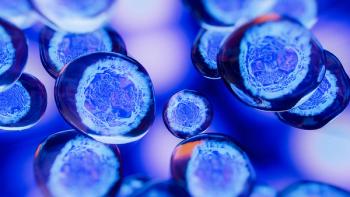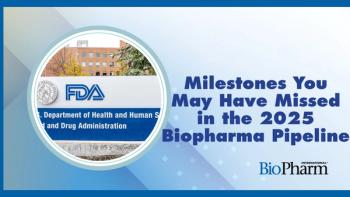
- BioPharm International-11-01-2014
- Volume 27
- Issue 11
Vector Manufacturing and Testing for Gene and Cell Therapy Applications
The authors offer insight into cell therapy manufacturing, vector production, and the safety aspects of testing for characterization.
Gene- and cell therapy-based medicines are experiencing resurgence due to the introduction of “next generation” transfer vectors, which have demonstrated improved safety and efficacy. Patient samples are often extracted, expanded, and transduced using gene-therapy vectors, and the modified cells are re-implanted in the patient for therapeutic applications.
In this circumstance, the modified cell is the drug product rather than the gene-transfer vehicle, and it carries with it distinct regulatory challenges. An increase in the number of candidate molecules is anticipated due to the interest in the cancer treatments based on recent successes seen with chimeric antigen receptor (CAR)-based cell therapies. Although the end product of the manufactured viral vector is considered a drug substance, in the case of cell therapies, the scrutiny for testing for adventitious agents is high. As in many cases, the transduced cell products possess short shelf lives, often before all release testing can be completed. In addition, the use of plasmids for generation of viral vectors adds another layer of compliance and testing.
Given the complexities associated with new technologies, especially with “first-in-class” applications, the technical and scientific input can be the deciding factor in the success of a testing and/or manufacturing program. Both the manufacturing process and the performance of routine (e.g., adventitious agent testing, mycoplasma, sterility) and custom-designed (e.g., identity, potency) assays need to meet clinical and regulatory compliance standards.
The authors offer insight into cell-therapy manufacturing, vector production, and the regulatory requirements and safety aspects of testing for characterization.
To illustrate the manufacturing and testing strategies for a complex cell-therapy production process, the multilevel production required to generate a CAR T cell therapy product can serve as a good example. This production process starts with generation of cell lines and transfection of these cells with plasmids to produce a viral vector, which is then used to transduce patient T cells, before these are reintroduced into the patient. This is a long and complicated path that involves, in many cases, three or more different manufacturers (for cell banks, plasmids, lentiviral vectors and patient cell manipulation). The overall process is shown in Figure 1.
In ex-vivo applications, gamma retroviral vectors, derived from murine leukemia virus (MLV), were the first to be used; however, lentiviral vectors, based on human immunodeficiency virus (HIV), have gained attention due to their ability to transduce non-dividing cells. While MLV has a simple genome structure (containing gag, pol, and env gene sequences), lentiviruses have a more complex one containing additional accessory genes that are able to manipulate host cell functions. The general strategy in designing lentiviral vectors for gene therapy is based on the deletion and alteration of the native viral sequences to prevent the generation of replication-competent retroviruses. To achieve this, the lentivirus components are segregated into three or four different plasmid constructs with the goal of preventing the possibility of complete recombination to a fully replication competent lentivirus (RCL). The viral vector genome contains at a minimum the transgene expression cassette, the long terminal repeats (LTRs), and the packaging signal. In most cases, three additional plasmids provide the factors required for virus production and packaging (e.g., gag, pol, env). The envelope proteins are typically replaced by a heterologous viral glycoprotein, most commonly vesicular stomatitis virus G-protein (VSV-G), to modify the host range of the vector. An important safety feature is also the deletion of the promoter-enhancer region from the 3’ LTR preventing transcription from this region and subsequent viral replication (self-inactivating vector; SIN).
The essential steps of ex-vivo gene therapy involve cell isolation and in-vitro culture of the desired cell type to allow the selection, expansion, and differentiation either before or after the cell has been transduced with a viral vector. In the case of hematopoeitic cells, most of these steps can be performed in a closed system using single-use blood collection and processing bags.
For CAR T cell therapy, patient blood cells are harvested, and the desired T cell populations are selected and grown to the required levels. They are then transduced with a viral vector carrying the CAR gene cassette, followed by CAR T cell expansion to the billion-cell level. Lentiviral vectors have been shown to transduce T cells more efficiently and are, therefore, the preferred vector for introducing CAR into patient target cells. Expanded cells are then reintroduced into the patient. To move quickly into patients, the testing window is relatively short, and administration of cells may be initiated before all testing is completed. This requires a balance of product risk and timely treatment of cancer patients.
Lentiviral vector production
Lentiviral vector cGMP production is frequently accomplished using adherent HEK293 (human embryonic kidney cells immortalized using sheared Adenovirus 5 DNA), or HEK293T cells (HEK293 cells containing the SV40 large T antigen gene) transiently transfected with plasmids providing the relevant vector components. The critical raw materials usually needed for vector production are the cells, medium and serum, and the plasmids. Each of these must be sourced from approved suppliers and should have gone through a rigorous testing program to reduce the risk of introducing adventitious agents into the production process. Master and working cell banks (MCBs and WCBs) and animal-derived media components are also extensively tested.
If fetal bovine serum (FBS) and porcine trypsin are used in production, they should be gamma irradiated to reduce the risk of viral contamination. FBS also carries the risk for bovine spongiform encephalopathy (BSE) contamination and, therefore, should be restricted to negligible BSE risk countries, such as the US, Australia, and New Zealand. Plasmids being produced in bacteria are tested for sterility and endotoxin levels. Similarly, the vector product requires testing for adventitious agents, purity, genetic identity, as well as potency before its release as a drug substance for transduction of cells ex vivo.
For lentiviral vector current good manufacturing practices (cGMP) manufacturing at the SAFC Carlsbad location, several approaches for scale-up are being pursued, including use of cell factories, Corning cellSTACK or HYPERStack. Depending on the size of the facility and the available incubator space, 20 to 40 cellSTACKs or up to 20 HYPERStacks can be incubated in parallel and still allow a consistent and reliable vector production. To allow consistent productivity, the plasmid transfections are done with polyethylenimine (PEI) as the transfection reagent, which does not require as high scrutiny with respect to pH and buffer consistency as the calcium phosphate based precipitation method. In many cases, the cells used for production are still grown in the presence of serum, which requires a higher scrutiny in testing, and efforts to implement serum-free production should be undertaken in sight of commercialization. Overall, efforts should be undertaken to move toward animal-free components, which apply to media components as well as cell propagation.
In comparison with other virus productions, where cell lysis is involved, retroviral or lentiviral vectors are harvested from supernatant, which may, dependent on the production system, also allow multiple harvests and thereby increase the overall yield. Supernatant volumes can reach 100 L or more, and require first a clarification and concentration step followed by column purification. The main criterion for purification is to obtain an acceptable vector concentration and assurance that the vector product has high transduction efficiency and does not compromise target cell functionality due to the presence of contaminants.
Regulatory requirements
Manufacture of viral vectors, including control of critical raw materials, is governed by regulatory guidelines issued by agencies such as FDA, the European Medicines Agency (EMA), and the Japanese Pharmaceuticals & Medical Devices Agency (PMDA).
EMA has produced specific guidance on the development and manufacture of lentiviral vectors (1). FDA has provided guidance for the manufacture and ex-vivo use of retroviral gene therapy vectors (2, 3). General guidance on the manufacture and quality control of gene therapy viral vectors is given in the United States Pharmacopeia (UPS) (4) and European Pharmacopoeia (Ph. Eur.) (5).
Rigorous testing of viral vector product, and the critical materials used in its manufacturing, are required to ensure the viral vector product is free of adventitious agents, and is fully characterized for its identity, purity, and activity. While cell banks and plasmids can be generated at qualified manufacturers or in-house under cGMP, other raw materials, like media, FBS, Benzonase, and PEI, must be scrutinized as well. Yet the viral vector manufacturer does not directly control production of these materials. Here, qualification of the relevant manufacturers, good supply chain control, and additional testing contribute to another level of complexity. Table I provides an overview of the testing required for cell banks, viral vector, and cell-therapy product.
Table I: Assays to characterize cell lines and viral vectors. MCB is master cell bank. WCB is working cell bank.
Assays
Human 293 producer cells
Lentiviral vector
(Bulk harvest)
Lentiviral vector
(Purified)
Ex-vivo transduced cells
MCB
WCB
Identity
Isoenzyme analysis
X
X
DNA fingerprinting
X
X
Genetic identity by sequencing of transgene
X
Genetic identity by restriction enzyme digest
X
Absence of microbial contamination
Sterility assay
X
X
X
X
X
Qualification of sterility assay
X
X
X
X
Mycoplasma assay
X
X
X
X
Qualification of mycoplasma assay
X
X
X
Absence of adventitious viruses
In-vitro assay for adventitious viruses (3 detector cell lines, 28-day assay)
X
X
X
In-vivo assay for adventitiousviruses (embryonated eggs, suckling and adult mice, GPs)
X
X
Transmission electron microscopy
X
PCR/RT-PCR assays for human viruses
X
PERT assay
X
Bovine virus assay
X
X
X
Porcine virus assay
X
X
X
Porcine circovirus
X
X
X
Absence of replication competent vectors
Replication competent lentivirus
X
X
X
Other tests
Titre of vector (infectivity and transducing efficiency)
X
X
X
Host cell DNA
X
Host cell protein
X
Residual bovine serum albumin
X
Residual plasmids
X
Osmolality
X
pH
X
Endotoxin
X
X
Aspects of safety testing
Safety for clinical use is paramount, and lentiviral vector preparations must be formally and extensively tested to show they are absolutely free of RCL. Various methods have been proposed to detect RCL, which report high specificity and sensitivity and can discriminate between replication-defective virus and RCL. Current testing recommendations include testing of material from multiple stages of the production process and from transduced patient cells. Both vector-producing cells and supernatant from production of an MCB should be tested for RCL using a cell line permissive for the RCL most likely to be generated. Regulatory requirements are to test 1% of the total cells or 108 (whichever is less) pooled vector-producing cells by co-culture with a permissive cell line. For supernatant, at least 5% of the total production harvest must be tested by amplification on a permissive cell line. Infectivity assays on cell supernatants or co-cultivation assays for RCL require several passages of detector cells and can take up to five weeks to complete in the laboratory.
At present, most ex-vivo therapies involve autologous donors where no screening for adventitious agents before transduction is done. After transduction, cells are tested using assays for sterility, absence of mycoplasma, RCL, and endotoxin. If the cell therapy product can be cryopreserved prior to administration back into the patient, classical assays for sterility and mycoplasma (which can take up to 28 days to perform) can be used.
However, in many cases, it is not possible to freeze cells, and in these cases, rapid tests must be used. This could be PCR (polymerase chain reaction) for mycoplasma, and rapid-cell-growth-based microbiological assays that can take less than three days, rather than the 14-day sterility assay. When transduced cells cannot be frozen, regulatory authorities have asked manufacturers to use a rapid assay for replication competent retrovirus (RCR) or RCL, such as PCR or PCR-based reverse transcriptase assays, which can be completed in days.
The longer assays for sterility and co-cultivation assays for RCL should also be run for initial studies—even if final assay results are only available after the patient has been treated with the cell therapy.
Testing strategies
Safety and other testing for characterization purposes can be done at select testing laboratories. The quality standard under which testing is performed varies with geographic region and stage of clinical development. In the US, the testing of starting materials such as cell banks, process intermediates, and drug substance for Phase I/II clinical trials may be performed to good laboratory practice (GLP). In the European Union, even for materials for early clinical trials, all manufacturing and quality control testing must be performed in licensed premises to cGMP standards.
Assays to detect adventitious agents need to be at least generically validated. All assays used for quality control of clinical material must be fit for purpose, and information about the specificity, sensitivity, and reproducibility of the assay system should be available. The extent of this qualification/validation data will increase to support later-stage clinical trials and product licensure. To navigate through the regulatory guidance and to implement a suitable testing strategy, the support of experienced testing laboratories can be valuable.
Testing of master and working cell banks is focused on safety and identity. For safety testing, absence of microbes is tested in sterility and mycoplasma assays. Testing to show absence of viruses requires the use of a number of different assays: broad specificity assays that detect a broad range of viruses by examination for cytopathic effects and haemadsorption in vitro; mortality/morbidity on embryonated eggs, mice and guinea pigs; and transmission electron microscopy.
PCR and reverse transcription PCR (RT-PCR) assays are used to detect viruses that are not detectable in the cells used for the in-vitro assay, and PCR-based reverse transcriptase (PERT) assays are used for the detection of endogenous and adventitious retroviruses. In addition, cells are tested for identity by isoenzyme analysis and DNA fingerprinting.
Plasmids used for transfections to produce viral vectors require testing for sterility and endotoxin to assure removal of all microbes used in their production. It is also crucial to confirm the viral vector specific sequences to assure generation of a homogeneous vector population. Plasmid purity, as well as stability, is essential to enable consistent transfection efficiencies.
Cell-bank and viral-vector testing have a strong focus on adventitious agent testing, specifically when using FBS or other animal-based materials in the manufacturing process. In addition, testing for replication competent viruses is required for manufactured viral-vector lots to ensure no infectious lentivirus was generated via recombination events during the manufacturing process.
More recently, the emergence of massive parallel sequencing (MP-Seq) technology provides the opportunity of sequencing total cell genomes quickly. This allows screening for the presence of unknown adventitious agents, as well as the analysis of the homogeneity and stability of vector populations. Already, these methods are applied in evaluation of unexpected test results in collaboration with regulatory agencies.
As a cGMP requirement, all raw materials used in production should be tested for identity. Bovine serum should be screened for growth promotion ability, absence of adventitious bovine viruses, and levels of anti-BVDV neutralizing antibodies. Porcine trypsin should be screened for absence of stable viruses such as porcine parvovirus, porcine circovirus, and porcine hepatitis E virus.
Conclusion
As the fields of gene and cell therapy continue to evolve, new vectors and applications are being explored, and new adventitious agents are being discovered. The testing strategies will require adjustments, and will become even more complex. However, new testing technologies like MP-Seq will add to the repertoire of testing, and will eventually make the advancing gene and cell therapy products safer, and product progression more effective. In the case of the emergence of the CAR T cell therapies, development of novel treatments will provide more options and drive the development of gene and cell therapy forward to cure patients.
References
1. EMA, CHMP/BWP/2458/03 (May 2005).
2. FDA, Guidance for Industry: Guidance for Human Somatic Cell Therapy and Gene Therapy (March 1998).
3. FDA, Supplemental Guidance on Testing for Replication Competent Retrovirus in Retroviral Vector Based Gene Therapy Products and During Follow-up of Patients in Clinical Trials Using Retroviral Vectors (November 2006).
4. USP <1047> “Gene Therapy Products” USP 37.
5. European Pharmacopoeia, 5.14 “Gene Transfer Medicinal Products for Human Use” Jan. 2010.
About the Authors
Wolf Klump, PhD, senior manager, Technical Services, SAFC
Martin Wisher, PhD, senior director, Quality Assurance & Regulatory Affairs, BioReliance
Alison Armstrong, PhD, senior director, Development Services, BioReliance
Audrey Chang, PhD, senior director, Development Services, BioReliance.
Articles in this issue
about 11 years ago
Germany Post AMNOG: Insights for BioPharmaabout 11 years ago
Standardizing Practices for Cellular Therapy Manufacturingabout 11 years ago
Setting Standards for Biotech Therapeutics in Indiaabout 11 years ago
Viral Clearance Challenges in Bioprocessingabout 11 years ago
Outside Looking Inabout 11 years ago
Cell Culture Consumables Prevent Contaminationabout 11 years ago
Hype vs. Healthabout 11 years ago
New Era for Generic Drugsabout 11 years ago
DoE Provides Benefits, but Preparation Is NecessaryNewsletter
Stay at the forefront of biopharmaceutical innovation—subscribe to BioPharm International for expert insights on drug development, manufacturing, compliance, and more.





